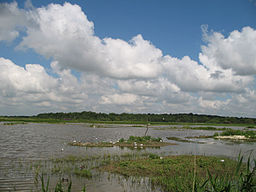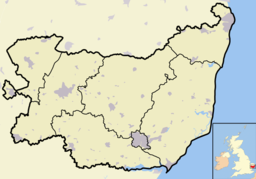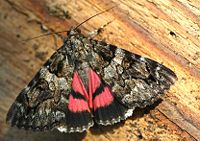- Minsmere RSPB reserve
-
Minsmere Nature reserve Looking west over the scrape at MinsmereCountry England Region East of England County Suffolk Coordinates 52°14′33″N 01°36′50″E / 52.2425°N 1.61389°E Area 9.69 km2 (4 sq mi) Biomes Reed bed, Lowland heath Geology Shingle Animal Bittern, Pied avocet, Western marsh harrier Founded 1947 Management Royal Society for the Protection of Birds For public Open year round Protection status SSSI, SAC, SPA, Ramsar Site and AONB Minsmere RSPB reserve shown within SuffolkWebsite: rspb.org.uk/minsmere Minsmere RSPB reserve is a nature reserve owned and run by the Royal Society for the Protection of Birds (RSPB) in Suffolk, England. It lies on the Suffolk coast to the south of Southwold and north of Aldeburgh within the Suffolk Coast and Heaths Area of Outstanding Natural Beauty (AONB) and the Suffolk Heritage Coast area. It is protected with SSSI, SAC, SPA and Ramsar Site conservation status.
The 9.69 square kilometres (3.74 sq mi) site was established in 1947 and covers areas of reed bed, lowland heath, lowland wet grassland, and shingle vegetation. The nature reserve is recognised for its high diversity of bird species and other wildlife and is used as a demonstration of successful reed bed management. It is known as one of the UK's premier bird watching sites.[1]
Contents
Ecology
The Minsmere reserve includes 1.79 square kilometres (0.69 sq mi) of reed bed habitat, representing 3.6% of the UK's reed beds,[2] as well as areas of open water, lowland heath, grassland, scrub, woodland, dune and shingle vegetation. The reserve is an important breeding, roosting and feeding site for many bird species with over 100 resident species and around a further 240 species of migratory visitors being recorded at the site.[3]
Up to 30% of the UK's breeding population of Great Bittern are to be found at Minsmere.[4] It is also of particular conservation importance for its populations of Western Marsh Harrier, Pied Avocet, Savi's Warbler, Bearded Reedling and Reed Bunting.
Heathland areas are particularly important for populations of Dartford Warbler and antlion and woodland areas are important for Nightingale populations. Other species found at Minsmere include adders, otter, water vole and one of the largest herds of Red deer in England.[2]
Over 1000 species of Lepidoptera (moths and butterflies) have been recorded at Minsmere. The 32 recorded butterfly species include the Silver-studded Blue, the Camberwell Beauty and the Queen of Spain Fritillary. In September 2004 the moth species Catocala conjuncta, which was previously unrecorded in Britain was found on the reserve. To acknowledge its place of capture it was given the common name Minsmere Crimson Underwing.[5]
Conservation
Protected status
The Minsmere nature reserve, its habitats and wildlife, are protected under UK law as a part of the 'Minsmere – Walberswick' Special Protection Area (SPA)[6] and Ramsar Site.[7] It is also protected as part of the 'Minsmere to Walberswick Heaths and Marshes' Special Area of Conservation (SAC)[8] and Site of Special Scientific Interest (SSSI).[9] The site is also included in the area covered by the Suffolk Coast and Heaths Area of Outstanding Natural Beauty (AONB)[10] and the Suffolk Heritage Coast area.[11]
 The reed beds and ditches are regularly cut and cleared to prevent ecological succession
The reed beds and ditches are regularly cut and cleared to prevent ecological succession
Management
The RSPB, through the work of employees and volunteers, actively manage the habitats of Minsmere nature reserve to maintain and improve the site for the benefit of wildlife and visitors. The reed beds are maintained by controlling water levels to prevent drought events and through rotational cutting to control ecological succession. The main reed beds are cut on a seven year rotation, with around 3 hectares (7.4 acres) cut annually and with ditches on a five to seven year rotation.[2]
Grazing of animals is used throughout the reserve to prevent the expansion of scrubland and to control ecological succession. In 2001 eight Polish Konik horses where bought to the reserve from a herd run by the Suffolk Wildlife Trust and now form a separate breeding herd.
 Konik horses grazing at Minsmere RSPB reserve
Konik horses grazing at Minsmere RSPB reserve
This breed is used at a number of nature reserves in England to provide year round, low intensity grazing of wetland areas. They are selected for their hardiness and ability to graze in very wet conditions. At Minsmere they, along with a herd of Highland cattle, help maintain the boundary between reed beds and open water areas and help control reed density, providing open water feeding pools for bitterns within the reed beds.[2][12]
Away from the reed beds Exmoor ponies and sheep are used to graze grassland and heath areas. The water levels and salinity of lagoons are controlled and during winter and spring grassland areas are flooded for the various bird populations. In woodland areas invasive plants are controlled and some areas fenced off to prevent damage from deer.[13]
The heathland and acidic grassland areas of Minsmere are managed with grazing, heather and scrub control and removal of invasive plants. In 1989, 158 hectares (390 acres) of former arable land was purchased in a project to recreate lowland heath and acidic grassland habitat by acidification of the soil. The aim being to join fragmented patches of heathland together and to provide increased habitat for the Stone Curlew, Woodlark and Nightjar, three threatened bird species.[14] In 2003, the success of this project was highlighted when stone curlews returned to nest for the first time at Minsmere and in 2007 two pairs successfully fledged six chicks.[15]
Bitterns and reed bed restoration
Minsmere is one of a small number of sites within the UK at which Great Bitterns breed. In 1979, nine booming males where counted but the population at Minsmere has varied over time, reaching a low of only one booming male in 1991.[16] The decline in bitterns is believed to be connected to the degradation and drying up, between the 1970s and 1990s, of the reed bed habitat it depends on. To combat this, during the 1990s an extensive program to restore large areas of the reed beds was undertaken with funding from the European Union LIFE Fund.
Over four years 38 hectares (94 acres) of reed bed that had dried out were excavated and lowered with layers of built up leaf litter and soil being removed. A total of 4,990 m of old ditches and meres were reinstated and reshaped and new ones created. Improved water control was put in place and deeper open water pools covering 1.6 hectares (4.0 acres) were created to improve fish numbers. In 1999, the North Levels project set out to create a further 28 hectares (69 acres) of prime bittern habitat that maximises a wetland habitat mosaic layout.
The bittern population at Minsmere responded positively to this work. In 2003, there was a count of 8 booming males and 8 to 10 nesting females and between 1994 and 2001 there were 52 bittern chicks that fledged. Many other species including Water Rails, Reed Warblers, and otters have benefited from the projects.[12][17]
Access and facilities
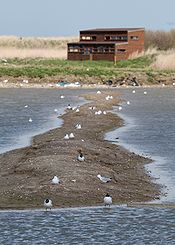 One of the bird hides at Minsmere RSPB reserve
One of the bird hides at Minsmere RSPB reserve
The reserve is accessible by car from the A12 via the village of Westleton. It is also connected to Route 1 of the Sustrans National Cycle Network by the Suffolk Coast Cycle route. The nearest bus access is in the town of Leiston 4 miles (6.4 km) away and rail access is in Darsham 5 miles (8.0 km) away.[18] Coastlink, a demand responsive bus service is available from these places to travel to the reserve but requires booking a day in advance.[19] Minsmere reserve is also accessible on foot from Dunwich Heath, Sizewell Beach and Eastbridge, with 12 miles (19 km) of public rights of way around reserve. The long-distance walks, the Suffolk Coast Path[20] and Sandlings Walk[21] connect to the reserve.
Minsmere has extensive footpaths throughout the site and seven bird hides are provided for birdwatching. Some but not all of these are accessible to wheelchair and buggy users. Only assistance dogs are allowed within the reserve, all other dogs must be kept within the car park, visitors centre or on the public rights of way that surround the site. A visitors centre provides a cafe, picnic area, shop, toilets and baby-changing facilities. There is also an information centre and guided walks, binocular hire and children's 'explorer packs' are available.[1]
Entry to the reserve is free for RSPB members and a fee is charged for non-members. The site is open daily during daylight hours, year round. The visitor centre and facilities are open from 9 am to 5 pm with some seasonal variations.
History
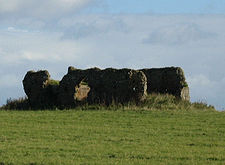 The ruins of Leiston Abbey chapel
The ruins of Leiston Abbey chapel
Reed beds were established at Minsmere during World War II when the existing grazing marshes were flooded as an anti-invasion measure.[2] The reserve was first established in 1947 when the RSPB leased around 1,500 acres (610 ha) from the Ogilive family. This land was then purchased in 1977 with further purchases of surrounding land expanding the reserve over the years.[17]
The ruins of Leiston Abbey chapel, a scheduled ancient monument, are visible at Minsmere. These archeological ruins are all that remain of the original Leiston Abbey, dating back to 1182. Threatened by flooding, the monks moved the abbey in 1363 to a site 2.5 miles (4.0 km) further inland. They abbey chapel was eventually abandoned during the dissolution of the monasteries in 1537. The RSPB commissioned an archeological evaluation of the site and were provided £47,600 for its conservation and repair by English Heritage and Natural England.[22]
References
- ^ a b Rix, Juliet (2006-10-08). "Days Out: Minsmere RSPB Reserve, Suffolk". London: The Independent. http://www.independent.co.uk/travel/news-and-advice/days-out-minsmere-rspb-reserve-suffolk-419233.html. Retrieved 2010-05-13.
- ^ a b c d e "Minsmere Management". Royal Society for the Protection of Birds. http://www.rspb.org.uk/ourwork/conservation/managingreserves/casestudies/reserves/minsmere/. Retrieved 2010-05-15.
- ^ "M is for Minsmere". BBC. http://www.bbc.co.uk/suffolk/dont_miss/a_z/minsmere.shtml. Retrieved 2010-05-15.
- ^ "Nature features - Booming Bitterns". BBC. http://www.bbc.co.uk/suffolk/content/articles/2006/02/08/booming_bittern_feature.shtml. Retrieved 2010-05-15.
- ^ "Moths at Minsmere – 1000 species and counting". BBC News. http://www.bbc.co.uk/suffolk/content/articles/2006/09/18/rspb_moths_2006_feature.shtml. Retrieved 2010-05-15.
- ^ "SPA description Minsmere – Walberswick". Joint Nature Conservation Committee. http://www.jncc.gov.uk/default.aspx?page=2009. Retrieved 2010-05-13.
- ^ "Designated and Proposed Ramsar sites in England". Joint Nature Conservation Committee. http://www.jncc.gov.uk/page-1390. Retrieved 2010-05-13.
- ^ "Minsmere to Walberswick Heaths and Marshes". Joint Nature Conservation Committee. http://www.jncc.gov.uk/ProtectedSites/SACselection/sac.asp?EUCode=UK0012809. Retrieved 2010-05-13.
- ^ "SSSI units for Minsmere-walberswick Heaths And Marshes". Natural England. http://www.english-nature.org.uk/special/sssi/unitlist.cfm?sssi_id=1000721. Retrieved 2010-05-13.
- ^ "Suffolk Coasts and Heaths". www.suffolkcoastandheaths.org. http://www.suffolkcoastandheaths.org/. Retrieved 2010-05-13.
- ^ "Suffolk Heritage Coast". Natural England. http://www.naturalengland.org.uk/ourwork/conservation/designatedareas/heritagecoasts/suffolk.aspx. Retrieved 2010-05-13.
- ^ a b "Minsmere - What we have achieved". Royal Society for the Protection of Birds. http://www.rspb.org.uk/ourwork/conservation/managingreserves/casestudies/reserves/minsmere/achieved.asp. Retrieved 2010-05-16.
- ^ "Minsmere - Our work here". Royal Society for the Protection of Birds. http://www.rspb.org.uk/reserves/guide/m/minsmere/work.aspx. Retrieved 2010-05-16.
- ^ Owen, K.M.; Marrs, R.H. (2000). "Creation of heathland on former arable land at Minsmere, Suffolk, UK: the effects of soil acidification on the establishment of Calluna and ruderal species". Biological Conservation (Elsevier Science Ltd.) 93 (1). doi:10.1016/S0006-3207(99)00118-4. http://www.sciencedirect.com/science?_ob=ArticleURL&_udi=B6V5X-3YJYH7W-2&_user=7302582&_coverDate=04%2F30%2F2000&_rdoc=1&_fmt=high&_orig=search&_sort=d&_docanchor=&view=c&_acct=C000010139&_version=1&_urlVersion=0&_userid=7302582&md5=4fa09d0d6373f77af1b953e3c86e5e2c.
- ^ "Ups and downs for rare birds on Suffolk coast". Science Centric. http://www.sciencecentric.com/news/07092403-ups-and-downs-for-rare-birds-on-suffolk-coast.html. Retrieved 2010-05-22.
- ^ Tyler, G.A.; Smith, K.W.; Burges, D.J. (1998). "Reedbed management and breeding bitterns Botaurus stellaris in the UK". Biological Conservation (Elsevier Science Ltd.) 86 (2): 257–266. doi:10.1016/S0006-3207(97)00174-2. http://www.sciencedirect.com/science?_ob=ArticleURL&_udi=B6V5X-3V60417-H&_user=7302582&_coverDate=11%2F30%2F1998&_rdoc=1&_fmt=high&_orig=search&_sort=d&_docanchor=&view=c&_searchStrId=1336967281&_rerunOrigin=google&_acct=C000010139&_version=1&_urlVersion=0&_userid=7302582&md5=f6929c5fbb3f8287d5ce3d911a4efa9d.
- ^ a b "Restoration - Minsmere RSPB reserve". BBC. http://www.bbc.co.uk/suffolk/dont_miss/restoration/minsmere/minsmere.shtml. Retrieved 2010-05-16.
- ^ "Minsmere - How to get here". Royal Society for the Protection of Birds. http://www.rspb.org.uk/reserves/guide/m/minsmere/directions.aspx. Retrieved 2010-05-13.
- ^ "Coastlink bus service". www.suffolkcoastandheaths.org. http://www.suffolkcoastandheaths.org/downloads.asp?PageId=64. Retrieved 2010-05-18.
- ^ "Suffolk Coast and Heaths Path". Long Distance Walkers Association. http://www.ldwa.org.uk/ldp/members/show_path.php?path_id=440. Retrieved 2010-05-19.
- ^ "Sandlings Walk". Long Distance Walkers Association. http://www.ldwa.org.uk/ldp/members/show_path.php?path_name=Sandlings+Walk. Retrieved 2010-05-19.
- ^ "New life for old chapel". Evening Star. http://www.eveningstar.co.uk/news/new_life_for_old_chapel_1_165139. Retrieved 2010-05-18.
- Axell, Herbert; & Hosking, Eric. (1978). Minsmere. Portrait of a Bird Reserve. Hutchinson: London. ISBN 0-09-128840-1
External links
- RSPB's Minsmere pages
- Minsmere on the VisitWoods website
Categories:- Royal Society for the Protection of Birds reserves in England
- Special Protection Areas in England
- Nature reserves in Suffolk
- Protected areas established in 1947
Wikimedia Foundation. 2010.

